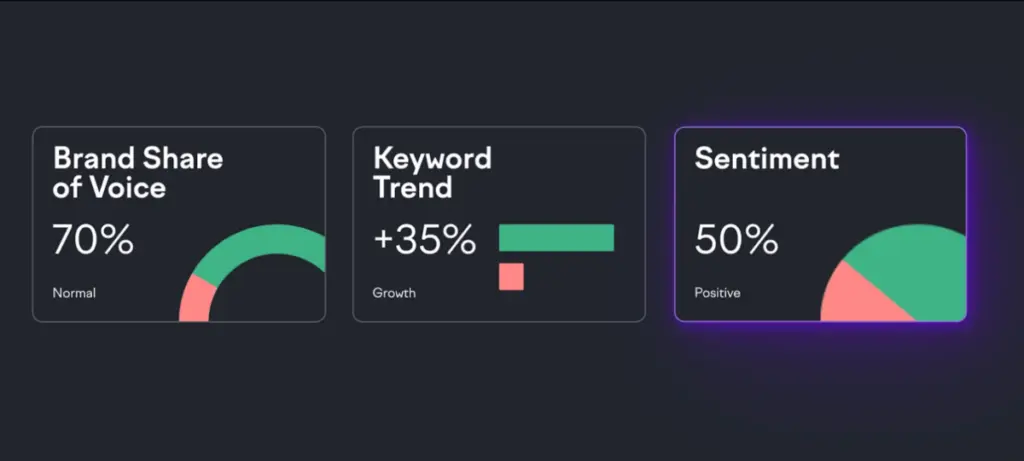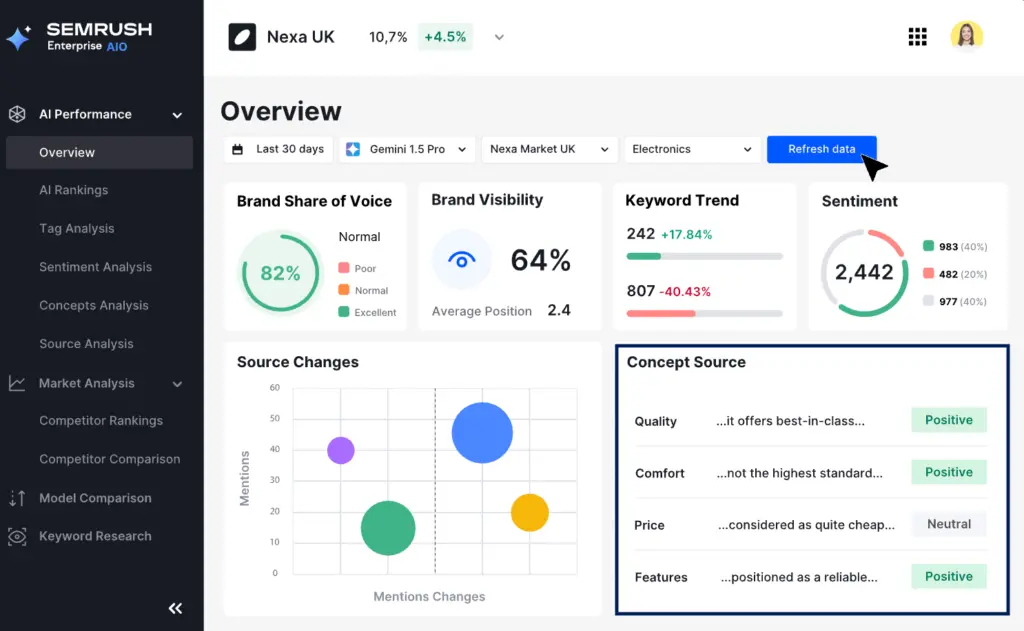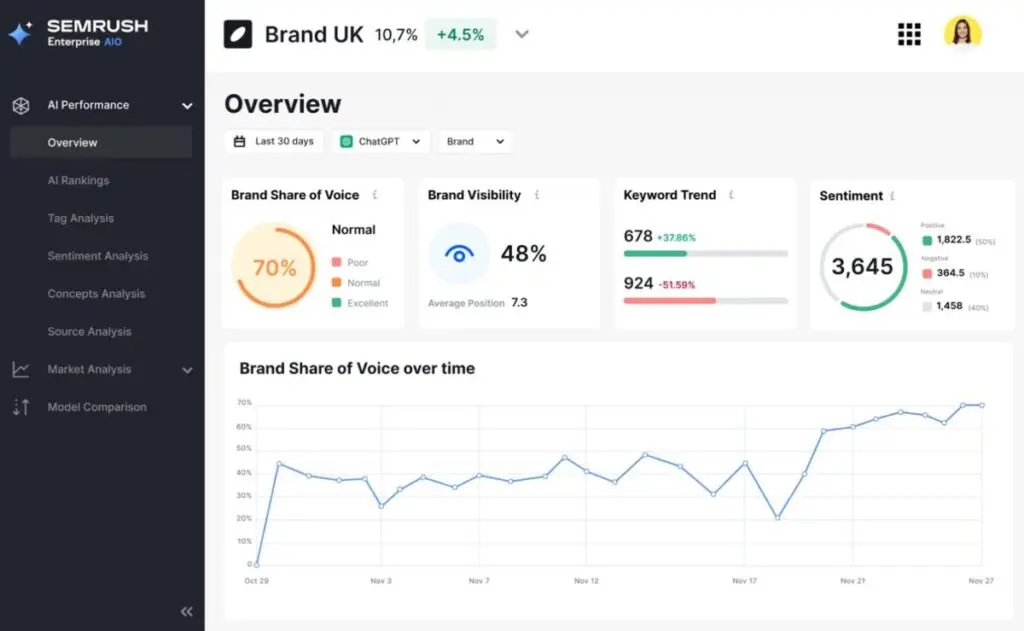AI is reshaping how brands are discovered. Search engines no longer just display ranked lists of websites—platforms like ChatGPT, Perplexity, and Gemini generate their own responses, pulling from countless sources to decide which brands make the cut. Traditional SEO alone is no longer enough and businesses that once relied on optimizing for search engines now face a new challenge: ensuring they are accurately represented in AI-generated content.
With this shift, competition is rising fast. More than half of businesses report a significant increase in competition due to AI-powered search, as companies fight to secure their place in AI-generated results. Unlike Google’s ranking system, AI doesn’t rely on backlinks or paid ads to determine visibility. Instead, it interprets relevance based on context, sentiment, and data patterns—meaning brands can be misrepresented, overlooked, or replaced without warning.
The brands that thrive in this new landscape will be the ones that take control. AI search may seem unpredictable, but the right tools can help businesses track, analyze, and optimize their AI visibility.This article explores how AI search is evolving, why businesses need to rethink their approach, and how they can ensure their brand remains front and center in AI-driven search.
Unlock powerful insights with SEMrush – get started today!
The Enterprise Challenge: Visibility in AI Search
AI-powered search engines are changing the way people discover brands. Unlike traditional search engines, which rank websites based on SEO factors, AI-driven platforms like ChatGPT, Perplexity, Gemini, and Claude generate responses dynamically. They synthesize information from multiple sources—some credible, some outdated, and some outright incorrect.
For businesses, this shift presents a serious risk: if AI search engines don’t surface accurate brand information, companies lose control of their digital presence. Unlike Google search results, which can be optimized through keyword strategy and backlinks, AI-generated responses are opaque, unpredictable, and constantly evolving.
This lack of control leads to three key challenges:
First, AI models can distort brand information. A rebranded product might still be listed under its old name. A discontinued service might appear as if it's still active. AI doesn’t prioritize official sources—it draws from a mix of news articles, user-generated content, and historical data, often without verifying accuracy. A well-documented example is Google’s Gemini AI, which falsely claimed that Gouda accounted for 50-60% of global cheese consumption, an error that quickly spread before it was corrected. If misinformation like this can circulate about a common food product, imagine the consequences for an enterprise brand.
Second, lost visibility is a growing problem. AI-generated search doesn’t rely on rankings—if a brand isn’t included in an AI response, it’s effectively invisible. Competitors that are actively optimizing for AI search will gain an advantage, positioning themselves as the default answers for industry-related queries. A McKinsey survey found that 78% of enterprises are already integrating AI into their business functions, and larger companies are adapting nearly twice as fast as smaller ones. This means the brands that take AI search seriously now will dominate consumer conversations in the future.
Finally, reputation risks are higher than ever. AI models don’t fact-check in real time—they generate responses based on patterns in existing data. If incorrect or misleading content about a brand exists online, AI could amplify it without context or verification. A report by IPG Magna found that when brands appear next to AI-generated misinformation, consumer trust drops significantly, even if users can’t confirm whether the content is true or false. This poses a major challenge for companies in regulated industries like finance and healthcare, where even minor inaccuracies can lead to legal or compliance issues.
The Rise of AI Optimization (AIO)
AI search isn’t just disrupting how brands appear online—it’s creating an entirely new playing field for digital visibility. Businesses that continue relying on traditional SEO tactics will find themselves competing in a system where rankings no longer guarantee visibility. Instead of reacting to AI-driven search changes, companies need a proactive approach that ensures they remain visible, accurately represented, and positioned ahead of competitors.
This is where AI Optimization (AIO) comes in. Unlike conventional SEO, which focuses on increasing website rankings, AIO is about ensuring that brands are correctly and consistently represented in AI-generated content. Since AI models generate their own responses rather than linking to official websites, companies must actively track where, when, and how AI platforms reference their brand—and adjust their strategies accordingly.
From Search Strategy to AI Optimization
Traditional SEO revolves around keywords, backlinks, and ranking algorithms, but AI search operates differently. AI-generated responses are based on context, authority, and user intent, meaning businesses must rethink how they position their brand for visibility.
AIO focuses on real-time monitoring, sentiment analysis, and competitive benchmarking—three pillars that allow businesses to stay ahead in AI-driven search. Real-time monitoring helps companies track AI-generated mentions as they happen, ensuring that they are aware of how often they appear in AI responses and in what context.
Sentiment analysis goes beyond visibility, analyzing whether AI models portray a brand positively, negatively, or neutrally. Competitive benchmarking reveals how often a company is mentioned relative to its competitors, identifying areas where it needs to strengthen its AI search strategy.
Industries Already Feeling the Impact of AI Search
Some industries are seeing the effects of AI-driven search more than others. For these businesses, AI Optimization is no longer optional—it’s essential for survival.
- Tech and SaaS companies compete for AI-driven software recommendations. When AI models summarize “best tools” for a task, a single response could determine which product businesses adopt.
- E-commerce and retail brands rely on AI shopping assistants, which filter purchase options based on reviews, availability, and trends—often without linking back to the company’s website.
- Financial institutions must ensure that AI-generated details about loan rates, investment products, and policies remain accurate to maintain consumer trust and meet compliance regulations.
- Healthcare companies need to monitor AI-generated medical information, where misrepresentation of treatments or drug efficacy could have serious consequences.
AI search isn’t just a shift in search behavior—it’s a shift in brand control. The companies that recognize this change and take action now will define their visibility in AI-driven search. Those that don’t will be left scrambling to regain control in a landscape they no longer influence.
The AI Search Era: How Enterprises Can Control Their Brand Narrative
For enterprises, the unpredictability of AI search isn’t just a challenge—it’s a call to action. AI-generated content now shapes consumer perception, influences purchase decisions, and defines competitive positioning. Brands that assume their messaging is being accurately represented risk losing visibility, credibility, and control over how they are perceived.
Instead of waiting to react when misinformation spreads or when a competitor gains AI search dominance, businesses must take a proactive approach. Managing AI search visibility goes beyond simply being aware of brand mentions—it requires understanding how AI models frame a brand, ensuring consistency across platforms, and making strategic adjustments to strengthen positioning.
Enterprise tools are already emerging to help businesses take control of this new search landscape. AI Optimization solutions offer real-time tracking of brand mentions, analysis of sentiment in AI-generated content, and competitor benchmarking to help companies position themselves effectively. Among them, Semrush’s Enterprise AI Optimization platform provides one of the most comprehensive approaches to AI search visibility, giving businesses the ability to monitor their presence across multiple AI search platforms and take action when necessary.
Tracking AI Mentions and Ensuring Visibility
AI-generated responses are fluid and constantly evolving. A company may appear in one search query but be excluded in another. Without proper tracking, businesses may not realize when their visibility declines or when AI models present outdated or misleading information about them.
To address this, Semrush’s AI Optimization platform enables businesses to monitor their brand mentions across AI search platforms in real time.
This allows them to assess how often they appear in AI-generated responses, what context their brand is placed in, and whether key aspects of their messaging are being recognized by AI models. Having access to this data makes it possible to identify patterns and take corrective measures when necessary, ensuring that a company’s brand presence remains strong and consistent.
Managing Brand Sentiment in AI Search
Being mentioned in AI-generated search is only part of the equation. How a brand is described is just as important. AI models synthesize information from a wide range of sources, and without oversight, companies risk being framed in a way that does not align with their actual messaging. In industries where reputation is critical, such as finance, healthcare, and technology, sentiment misalignment can influence customer trust and purchasing decisions.
Semrush’s AI Optimization tool includes sentiment analysis capabilities that allow businesses to evaluate whether AI-generated responses portray them in a positive, neutral, or negative light.
This data helps companies measure how their brand is perceived, track sentiment trends over time, and take action to correct any inaccuracies or misleading narratives before they gain traction.
Benchmarking AI Search Visibility Against Competitors
AI search is shaping how industries are represented, and brands that do not actively manage their presence risk being overshadowed by competitors. AI-generated responses are not influenced by traditional ranking factors, meaning that a competitor who secures more AI visibility may dominate search results without necessarily having better SEO. For enterprises that rely on strong brand positioning, this shift requires a new approach to competitive analysis.
Semrush’s platform allows businesses to benchmark their AI search presence against competitors by analyzing how often rival brands appear in AI-generated responses.
Companies can track which competitors are being prioritized by AI search engines, understand the types of queries that favor them, and adjust their own positioning strategies to strengthen their visibility. This data-driven approach ensures that businesses are not left behind as AI search reshapes the competitive landscape.
Ensuring Accuracy and Consistency in AI-Generated Search Responses
One of the risks of AI search is that brands are often defined by outdated or incorrect information. AI models do not always verify the accuracy of the content they generate, and unless brands actively monitor their presence, they may not realize when AI search engines present misleading details about their products, services, or company history.
Semrush’s AI Optimization platform allows businesses to track AI-generated responses for inaccuracies and take corrective action. By identifying inconsistencies early, companies can work to correct misleading narratives and ensure that AI search engines reflect their most up-to-date messaging. This is particularly important for businesses undergoing rebranding, launching new products, or working in regulated industries where misinformation can have serious consequences.
The Future of AI Search & What Comes Next
AI search is no longer an experimental technology—it is rapidly becoming the default way people discover information. As models grow more sophisticated, they will integrate more real-time data, refine their ability to assess credibility, and expand beyond text-based responses to include interactive and multimodal formats. The way businesses appear in AI-generated search will continue to shift, and those that are not actively managing their presence risk being misrepresented, overlooked, or replaced by more proactive competitors.
For enterprises, this is not just a question of adapting—it is a question of staying relevant. The companies that take action now, implementing AI Optimization strategies and leveraging tools designed for this new search era, will be the ones that shape how they are perceived, remain visible in AI-driven conversations, and secure a competitive advantage. AI search is evolving, and businesses have two choices: define their place in it or let AI define it for them.
Now is the time to take control.
Frequently Asked Questions
What is AI Search?
AI search refers to search engines powered by artificial intelligence, such as ChatGPT or Google Gemini, that generate conversational, personalized, and contextually relevant responses instead of simply returning links to web pages.
Why is managing AI search visibility important for businesses?
Managing AI search visibility is crucial because AI-generated answers can directly shape consumer perceptions about a brand, impacting reputation, trust, and sales. Businesses risk losing visibility, control over their messaging, and may face misinformation if they don't optimize for AI-driven search.
How is AI search different from traditional SEO?
AI search differs from traditional SEO because it focuses on conversational, personalized answers generated from extensive data sets rather than keyword-driven web page rankings. AI search emphasizes context, accuracy, and relevance, rather than backlinks or traditional ranking factors alone.
Can businesses control how AI search engines display their brand?
Businesses cannot fully control AI-generated results but can significantly influence them by providing accurate, structured, and frequently updated information. Actively managing digital content, utilizing structured data markup, and maintaining brand consistency can help guide AI search outputs.
What factors influence brand visibility in AI-generated search results?
Factors influencing brand visibility in AI search include accuracy and recency of data, brand authority and credibility, clarity of structured information, consistency across digital platforms, and user engagement signals such as popularity or frequency of search queries related to the brand.
How does AI Optimization (AIO) help enterprises stay ahead?
AI Optimization tools help businesses:
- Monitor AI mentions in real-time across multiple platforms.
- Analyze sentiment and accuracy of brand-related AI responses.
- Benchmark against competitors to identify gaps in visibility.
Improve content strategies to influence AI-generated search results.
What’s the future of AI search and brand optimization?
The future of AI search and brand optimization will increasingly involve proactive content management, real-time monitoring of brand representation, and leveraging structured, AI-friendly content strategies. Businesses will need to integrate advanced AI analytics, semantic SEO, and reputation management tools to ensure optimal visibility and accuracy.






